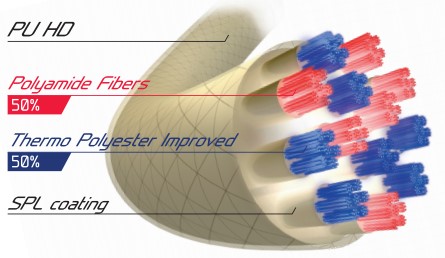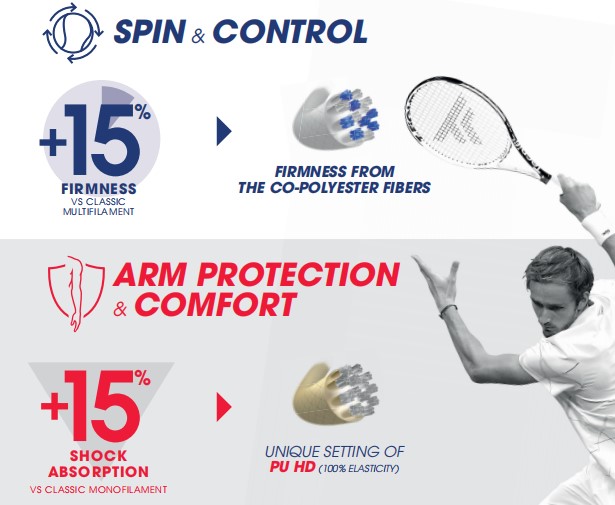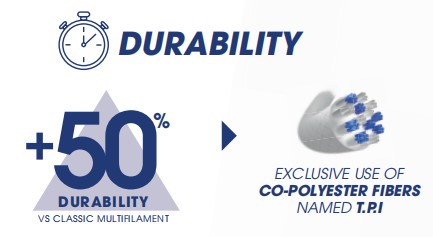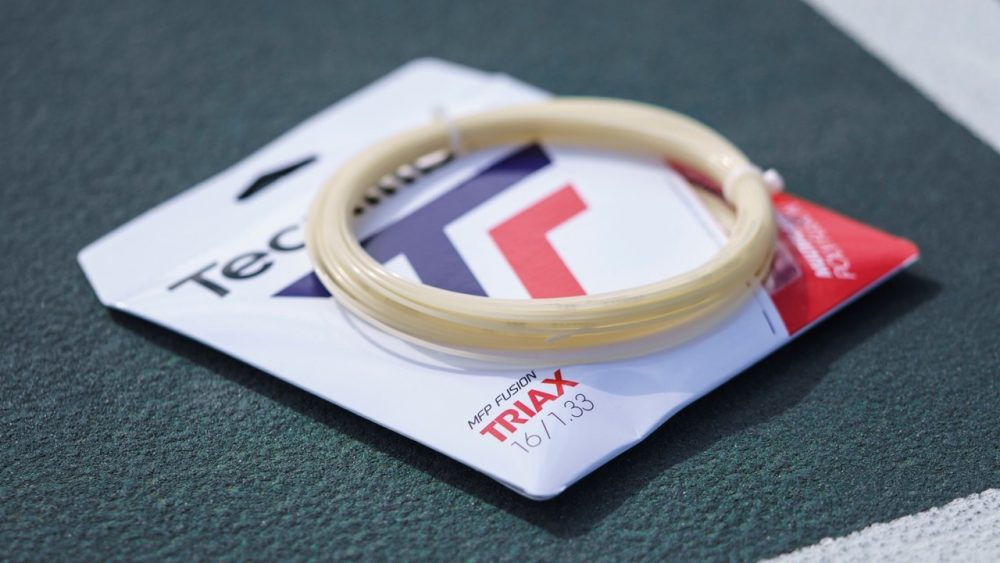Tecnifibre has been a leader in manufacturing the finest tennis strings around the world for decades. In 1983, the brand began using polyurethane for the construction of their synthetic strings and the rest as they say is history. Every brand under the sun now uses polyurethane to create more comfortable multifilament strings.
Over the last several years, Tecnifibre has been mixing different materials to try and create the “missing link” between the stiffer, control-oriented polyester string and softer, more powerful multifilament string. The brand’s newest addition, Triax, looks to close that gap by creating an internal Multi-Poly Fusion.
Triax is constructed of 50% polyamide fibers and 50% thermo improved polyester. Tecnifibre added their anti-abrasion SPL coating to enhance the strings durability. In their research, Tecnifibre found Triax to play 15% firmer than a typical multifilament, and absorb 15% more shock than an average monofilament. Perhaps most striking is their claim that Triax is 50% more durable than the typical multifilament string.

Full Disclosure, I tested Triax with skepticism, as I consider myself addicted to the controlled and firm feel of polyester strings. While stringing Triax, it felt very much like a multifilament and it stretches quite a bit. I tend to string polyester at or around 50 pounds, and I decided to string Triax at 56/58 pounds to counteract some of the strings’ power. I got myself all psyched up, and headed to the courts for the play test.
Realignment

One of the hallmarks of a smooth polyester string, is that it realigns or “snaps-back” in line after contact. With most synthetic and multifilament options, aggressive swings result in a string bed with deflected strings that need to be straightened to maintain a consistent response. For the first several hours, Triax realigned just like a polyester, and it didn’t require any straightening after long rallies or heavier ground strokes.
Triax’s ability to snap back, helped keep the playtest focused on the overall performance of the string instead of the fact it was a multifilament.
Feel & Comfort
Triax is another arm-friendly and comfortable string from Tecnifibre. It played with more relative stiffness than a string like NRG or X-One Biphase, but way more explosive and plush than a polyester. Volleys were easy to control and packed plenty of power.
Power, Spin, & Control
When really going after groundstrokes, the control and spin potential of Triax was easily apparent. While over hitting can still occur, balls hit outside the sweet spot seemed to find their way into the court as opposed to flying over the baseline. Triax offers a nice boost of power on put-away volleys and it provides much more energy return and resiliency than any polyester. The string handles these three attributes as impressively as any multifilament on the market.

Durability
Most multifilaments offer comfort and feel but at the expense of durability. Triax did a good job resisting notching from the outset, but I did start to notice some minor fraying around the 15-16 hour mark. The string exhibited solid snap back for a good period of time, but as the string surface became more worn, realignment suffered a bit. Despite the string fraying slightly, it remained playable for a long period of time.
Overall
Tecnifibre might be on to something with their new fusion string category. Triax maintains the comfort and feel of an excellent multifilament string, with improvements in control and durability. Polyester offers a predictable, sometimes dead feel, but the combination can put strain on elbow joints. Triax is a more arm friendly string option that maintains control.
Note: This playtest was conducted at 56/58 pounds in a HEAD Graphene 360+ Gravity Tour.
 About the Author/Playtester Sam Jones:
About the Author/Playtester Sam Jones:
Sam currently works at Tennis Express on the Content Marketing team. He previously played at Southwestern University, taught tennis for 10+ years and earned his Master Racquet Technician Certification in 2011. He is an active USTA League and Tournament player at the 5.0+ level.
For More:
Subscribe for More!
We send periodic updates detailing our recent posts.





